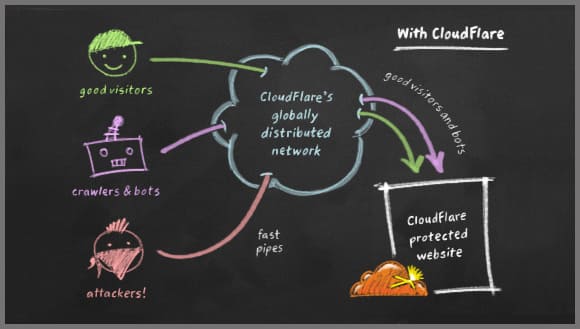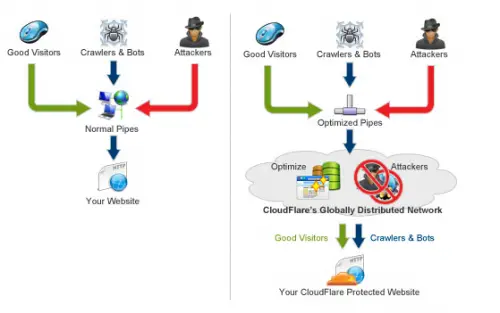Benefits of Integrating Cloudflare with Your Web Applications

Cloudflare is a global cloud-based network that provides a range of services to improve the performance, security, and reliability of websites and web applications. By integrating Cloudflare with your web applications, you can benefit from:

- Improved Performance: Cloudflare’s network of servers is distributed across the globe, which means that your website or application will be served from the nearest location to your users. This can significantly reduce latency and improve page load times.
- Enhanced Security: Cloudflare provides a range of security features, including DDoS protection, web application firewall (WAF), and bot management. These features can help to protect your website or application from attacks and malicious traffic.
- Increased Reliability: Cloudflare acts as a reverse proxy, which means that it sits between your web application and your users. This can help to improve the reliability of your application by providing redundancy and load balancing.
- Reduced Costs: Cloudflare can help you to reduce the cost of your website or application by providing a range of features that can reduce bandwidth usage and improve performance. For example, Cloudflare’s CDN can cache static content, which can significantly reduce the amount of bandwidth used by your website.
- Improved User Experience: By improving the performance, security, and reliability of your website or application, Cloudflare can help to improve the user experience for your visitors. This can lead to increased engagement, conversions, and revenue.
Overall, integrating Cloudflare with your web applications can provide a range of benefits that can improve the performance, security, reliability, cost, and user experience of your website or application.## The Benefits Of Integrating Cloudflare With Your Web Applications

Executive Summary
Integrating Cloudflare with your web applications offers numerous benefits, including enhanced security, improved performance, and reduced costs. By leveraging Cloudflare’s global network and advanced features, you can protect your applications from malicious attacks, optimize content delivery, and create a seamless user experience. This article explores the key advantages of integrating Cloudflare and provides practical guidance for implementation.
Introduction
In today’s digital landscape, the reliability and security of web applications are paramount. Cloudflare is a leading cloud-based platform that empowers businesses to enhance the performance and protection of their online assets. By integrating Cloudflare with your web applications, you can harness a suite of powerful features that safeguard against threats, accelerate content delivery, and optimize resource utilization.
Frequently Asked Questions (FAQs)
1. What is Cloudflare and how does it work?
Cloudflare is a content delivery network (CDN) and distributed denial-of-service (DDoS) protection service. It acts as a reverse proxy, intercepting incoming requests to your web applications and routing them through its global network of servers. This provides numerous benefits, including reduced latency, improved availability, and enhanced security.
2. How can Cloudflare benefit my web application?
Integrating Cloudflare with your web application offers a wide range of advantages, including:
- Enhanced security: Protection against DDoS attacks, web application firewall (WAF), and SSL/TLS encryption.
- Improved performance: Content caching, image optimization, and HTTP/2 and HTTP/3 support.
- Reduced costs: Reduced bandwidth consumption, server workload, and infrastructure expenses.
3. How do I integrate Cloudflare with my web application?
Integrating Cloudflare with your web application is relatively straightforward. You need to create an account, add your domain, and configure your DNS settings to point to Cloudflare’s servers. Cloudflare provides detailed documentation and support resources to guide you through the process.
Top 5 Subtopics
1. Security
- DDoS Protection: Cloudflare’s global network and advanced algorithms mitigate DDoS attacks, protecting your web applications from downtime and data breaches.
- Web Application Firewall (WAF): Cloudflare’s WAF blocks malicious traffic and exploits, such as SQL injection and cross-site scripting (XSS), safeguarding your applications from security vulnerabilities.
- SSL/TLS Encryption: Cloudflare provides SSL/TLS encryption for your web applications, ensuring secure data transfer and compliance with industry standards.
- Bot Management: Cloudflare’s bot management capabilities identify and block malicious bots, preventing them from scraping content or launching attacks.
2. Performance
- Content Caching: Cloudflare caches frequently accessed content on its servers, reducing latency and improving page load times.
- Image Optimization: Cloudflare automatically optimizes images for web delivery, reducing file sizes and improving performance.
- HTTP/2 and HTTP/3 Support: Cloudflare supports HTTP/2 and HTTP/3 protocols, providing faster and more efficient content delivery.
- Load Balancing: Cloudflare distributes incoming traffic across multiple servers, ensuring optimal resource utilization and preventing performance bottlenecks.
3. Cost Optimization
- Reduced Bandwidth Consumption: Cloudflare’s caching and content optimization techniques reduce the amount of bandwidth consumed by your web applications, lowering data transfer costs.
- Server Workload Reduction: By caching content and handling security threats, Cloudflare reduces the workload on your servers, freeing up resources for other tasks.
- Infrastructure Savings: Cloudflare’s global network eliminates the need for additional infrastructure, reducing hardware and maintenance costs.
- Pay-As-You-Go Billing: Cloudflare offers flexible pricing plans that allow you to pay only for the resources you use, optimizing your expenses.
4. Reliability
- Global Network: Cloudflare’s network of data centers spans the globe, ensuring high availability and redundancy for your web applications.
- Uptime Guarantee: Cloudflare offers a 99.9% uptime guarantee, ensuring minimal downtime and uninterrupted access to your applications.
- DNS Failover: Cloudflare’s DNS failover feature automatically reroutes traffic to healthy servers in case of an outage, preventing service disruption.
- Proactive Monitoring: Cloudflare continuously monitors your web applications for performance and security issues, providing timely alerts and support.
5. Analytics and Insights
- Web Analytics: Cloudflare provides detailed analytics on website traffic, visitor behavior, and performance metrics.
- Performance Dashboard: A user-friendly dashboard offers real-time insights into the health and performance of your web applications.
- Threat Intelligence: Cloudflare’s threat intelligence platform tracks and analyzes global threat patterns, providing early warnings and proactive protection.
- Customization: Cloudflare allows you to customize your settings and features to meet the specific needs of your web applications.
Conclusion
Integrating Cloudflare with your web applications offers a comprehensive solution for enhancing security, improving performance, and optimizing costs. By leveraging Cloudflare’s global network, advanced features, and reliable platform, you can create a secure and responsive online presence. Whether you are managing a small website or a large-scale enterprise application, Cloudflare empowers you to deliver an exceptional user experience while ensuring the integrity and availability of your web assets.
Keyword Tags
- Cloudflare
- Web Application Security
- Content Delivery Network (CDN)
- Website Performance Optimization
- Cloud-Based Services
